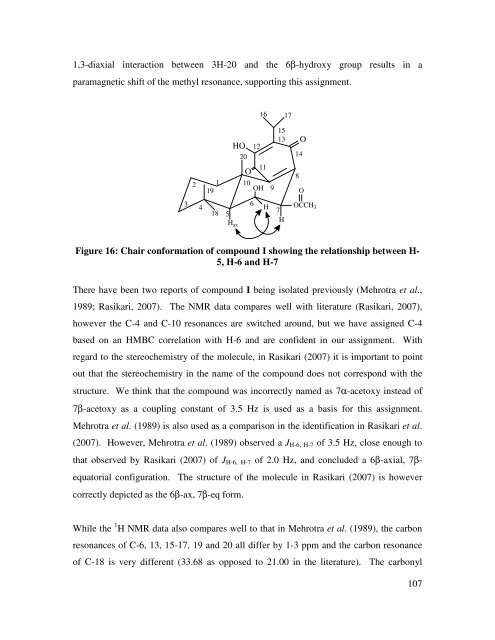university of kwazulu-natal faculty of science and agriculture school ...
university of kwazulu-natal faculty of science and agriculture school ...
university of kwazulu-natal faculty of science and agriculture school ...
Create successful ePaper yourself
Turn your PDF publications into a flip-book with our unique Google optimized e-Paper software.
1,3-diaxial interaction between 3H-20 <strong>and</strong> the 6β-hydroxy group results in a<br />
paramagnetic shift <strong>of</strong> the methyl resonance, supporting this assignment.<br />
3<br />
2<br />
4<br />
1<br />
19<br />
18<br />
5<br />
HO<br />
20<br />
H ax<br />
O<br />
10<br />
OH<br />
6<br />
12<br />
16 17<br />
11<br />
H<br />
9<br />
15<br />
13<br />
7<br />
H<br />
14<br />
8<br />
O<br />
O<br />
OCCH 3<br />
Figure 16: Chair conformation <strong>of</strong> compound I showing the relationship between H-<br />
5, H-6 <strong>and</strong> H-7<br />
There have been two reports <strong>of</strong> compound I being isolated previously (Mehrotra et al.,<br />
1989; Rasikari, 2007). The NMR data compares well with literature (Rasikari, 2007),<br />
however the C-4 <strong>and</strong> C-10 resonances are switched around, but we have assigned C-4<br />
based on an HMBC correlation with H-6 <strong>and</strong> are confident in our assignment. With<br />
regard to the stereochemistry <strong>of</strong> the molecule, in Rasikari (2007) it is important to point<br />
out that the stereochemistry in the name <strong>of</strong> the compound does not correspond with the<br />
structure. We think that the compound was incorrectly named as 7α-acetoxy instead <strong>of</strong><br />
7β-acetoxy as a coupling constant <strong>of</strong> 3.5 Hz is used as a basis for this assignment.<br />
Mehrotra et al. (1989) is also used as a comparison in the identification in Rasikari et al.<br />
(2007). However, Mehrotra et al. (1989) observed a JH-6, H-7 <strong>of</strong> 3.5 Hz, close enough to<br />
that observed by Rasikari (2007) <strong>of</strong> JH-6, H-7 <strong>of</strong> 2.0 Hz, <strong>and</strong> concluded a 6β-axial, 7β-<br />
equatorial configuration. The structure <strong>of</strong> the molecule in Rasikari (2007) is however<br />
correctly depicted as the 6β-ax, 7β-eq form.<br />
While the 1 H NMR data also compares well to that in Mehrotra et al. (1989), the carbon<br />
resonances <strong>of</strong> C-6, 13, 15-17, 19 <strong>and</strong> 20 all differ by 1-3 ppm <strong>and</strong> the carbon resonance<br />
<strong>of</strong> C-18 is very different (33.68 as opposed to 21.00 in the literature). The carbonyl<br />
107

















